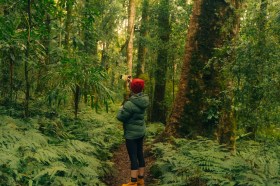Gail Jones’ novels are exceptional literary works. The Name of the Sister is her best book since the award-winning The Death of Noah Glass (2018). Jones hitches her sophisticated thematic and stylistic patterning and imagery to the propulsive plotting of the crime genre in the two novels to great effect.
An injured, malnourished young woman staggers onto a road near the iconic NSW mining town of Broken Hill in The Name of the Sister. She is found by Terry, a local who seems hapless in an emergency. The woman is mute. After being labelled a ‘Jane Doe’ and her photo released to the public, a long-suffering, almost-forgotten section of the community impacted by the loss of loved ones come forward. Although suffused by grief, most hope to claim her as their lost daughter, sister, fiancée or friend.
Freelance journalist Angie is at a loose end since quitting her job. Her marriage to high school English teacher Sam is shaky. In a prescient subplot, Sam directs his students in a re-enactment of Hamlet rather than endure their pointless, coerced readings from the text. It doesn’t end well.
Angie is consumed by the case of the unidentified woman. Her best friend, Bev, is the detective in charge. Bev must establish ‘Jane’s’ identity and the site of her entrapment. Bending the rules, she gives Angie information that leads to contact with those left in limbo by death and unanswered questions. Angie collects the voices to produce “not a crime story but something broader”. She decries and challenges the immediate, instinctive reactions of herself and others towards victims of crime. Along with the public and police, she is too quick to minimise their status into categories or generalisations defined by age, gender and race. The confessional interviews chafe Angie’s spirit and impact the plot.
Bev is deployed to supervise the investigation in Broken Hill. Misogyny, one of the novel’s main themes, escalates against her and her female co-workers. Worried about her friend’s isolation and wanting to help solve the crime, Angie arrives in the outback.
The Name of the Sister becomes an atmospheric vessel for Jones’ ineradicable images. The contrast between the harbour, water and verdant vegetation of Sydney (which reflects Jones’ seminal 2011 novel, Five Bells) against the dry, desert-like surrounds of the well-named ‘Broken’ Hill, with its eyesore slagheap, is striking. Angie describes the colour near the mines as ‘chromatic’, a term usually found in music. It here delineates ‘every surface [as] modified and refracted by this superabundance of light’. Jones artfully describes the luminance of the harbour and desert.
The author also explores motifs of pilgrims, lacrimarium bottles that hold tears, ancient Egypt and unsettling masks. Although now regarded as a nuisance in urban Australia, the ibis was sacred in Egypt, where the god Thoth wore a mask to honour the bird. The author symbiotically melds these diverse symbols into a mosaic.
The title hints at another major theme: sisters and sisterhood, and their encircling, protective bond. Artist designer W H Chong conjures Jones’ juxtaposition of sisters and birds in his enigmatic cover illustration. The friendship and love of sisterhood is portrayed as deep, layered and cherished through the book’s female relationships.
Read: Book review: I HOPE YOU’RE HAPPY, Marni Appleton
The characters in The Name of the Sister tell stories to reveal themselves to others and give comfort. Angie is swept into the tales. She is a woman composed of a spindrift of words. Personifying the author’s inscribed, elegant writing and storytelling, she connects patterns of images and parables to make sense of the world.
The Name of the Sister, Gail Jones
Publisher: Text Publishing
ISBN: 9781923058538
Pages: 208pp
RRP: $34.99
Publication date: 3 June 2025





